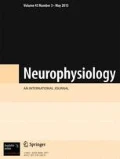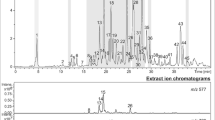Valeriana officinalis has been extensively used as a herbal remedy in traditional medicine. However, there is no clear evidence on the antinociceptive effects of this plant. The aim of our study was to evaluate the effect of Valeriana officinalis hydroalcoholic extract on pain modulation and its possible mechanism in mice. Adult male Balb/c mice were randomly divided into nine experimental groups. They received i.p. injections of saline, hydroalcoholic root extract of Valeriana officinalis (800, 200, or 50 mg/kg), and morphine; four groups received Valeriana (800 mg/kg) + antagonists of the systems involved in antinociception effects, naloxone, ondansetron, metoclopramide, or scopolamine. Tail-flick and writhing tests were used for estimation of possible modulation of pain. The tail-flick latencies in the Valeriana 800 and 200 mg/kg, but not 50 mg/kg, morphine, and combined Valeriana 800 + + naloxone, ondansetron, metoclopramide, or scopolamine-treated groups were significantly longer than that in the control group. However, the tail-flick latencies in the Valeriana 800 mg/kg + ondansetronand metoclopramide-treated groups were significantly shorter than that upon single action of the extract (800 mg/kg). The numbers of writhings in the extract-treated groups were smaller than in the control one. The numbers of writhings in the Valeriana (800 mg/kg) + ondansetron- and metoclopramidetreated groups were significantly greater than in the extract (800 mg/kg) group. It is concluded that Valeriana officinalis extract possesses a clear analgesic effect and works through the serotonergic and dopaminergic systems.
Similar content being viewed by others
References
J. B. Calixto, A. Beirith, J. Ferreira, et al. , “Naturally occurring antinociceptive substances from plants,” Phytother. Res., 14, No. 6, 401-418 (2000).
M. A. O’Hara, D. Kiefer, K. Farrell, and K. Kemper, “A review of 12 commonly used medicinal herbs,” Arch. Fam. Med., 7, No. 6, 523-536 (1998).
C. S. Yuan, S. Mehendale, Y. Xiao, et al., “The gammaaminobutyric acidergic effects of valerian and valerenic acid on rat brainstem neuronal activity,” Anesth. Analg., 98, No. 2, 353-358 (2004).
C. Stevinson and E. Ernst, “Valerian for insomnia: a systematic review of randomized clinical trials,” Sleep Med., 1, No. 2, 91-99 (2000).
L. M. Del Valle-Mojica, J. M. Cordero-Hernández, G. González-Medina, et al., “Aqueous and ethanolic Valeriana officinalis extracts change the binding of ligands to glutamate receptors,” Evid.-Based Complement. Alternat. Med., Article ID 891819, 7 pages (2011).
S. Hadley and J. J. Petry, “Valerian,” Am. Fam. Physician, 67, No. 8, 1755-1758 (2003).
J. O. Malva, S. Santos, and T. Macedo, “Neuroprotective properties of Valeriana officinalis extracts,” Neurotox. Res., 6, No. 2, 131-140 (2004).
A. Diaper and I. Hindmarch, “A double-blind, placebocontrolled investigation of the effects of two doses of a valerian preparation on the sleep, cognitive and psychomotor functions of sleep-disturbed older adults,” Phytother. Res., 18, No. 10, 831-836 (2004).
S. Bent, A. Padula, D. Moore, et al., “Valerian for sleep: a systematic review and meta-analysis,” Am. J. Med., 119, No. 12, 1005-1012 (2006).
R. Fachinetto, J. G. Villarinho, C. Wagner, et al., “Valeriana officinalis does not alter the orofacial dyskinesia induced by haloperidol in rats: role of dopamine transporter,” Prog. Neuropsychopharmacol. Biol. Psychiat., 31, No. 7, 1478-1486 (2007).
M. Marder, H. Viola, C. Wasowski, et al., “6-Methylapigenin and hesperidin: new valeriana flavonoids with activity on the CNS,” Pharmacol. Biochem. Behav., 75, No. 3, 537-545 (2003).
P. J. Houghton, “The scientific basis for the reputed activity of Valerian,” J. Pharm. Pharmacol., 51, No. 5, 505-512 (1999).
E. M. Choi, “Antinociceptive and antiinflammatory activities of pine (Pinus densiflora) pollen extract,” Phytother. Res., 21, No. 5, 471-475 (2007).
S. R. Mada, M. R. Metukuri, L. Burugula, et al., “Antiinflammatory and antinociceptive activities of gossypin and procumbentin–cyclooxygenase-2 (COX-2) inhibition studies,” Phytother. Res., 23, No. 6, 878-884 (2009).
S. McCabe, “Complimentary herbal and alternative drugs in clinical practice,” Perspect. Psychiatr. Care, 38, No. 3, 98-107 (2002).
P. Morazzoni and E. Bombardelli, “Valeriana offcinalis: traditional use and recent evaluation of activity,” Fitoterapia, 66, 99-112 (1995).
R. Della Loggia, A. Tubaro, and C. Redaelli, “Evaluation of the activity on the mouse CNS of several plant extracts and a combination of them,” Riv. Neurol., 51, 297-310 (1981).
D. Kennedy, W. Little, C. Haskell, and A. Scholey, “Anxiolytic effects of a combination of Melissa officinalis and Valeriana officinalis during laboratory induced stress,” Phytother. Res., 20, 96-102 (2006).
I. Oliva, M. Gonzalez-Trujano, J. Arrieta, et al., “Neuropharmacological profile of hydroalcohol extract of Valeriana edulis ssp. procera roots in mice,” Phytother. Res., 18, 290-296 (2004).
E. Abourashed, U. Koetter, and A. Brattstrom, “In vitro binding experiments with Valerian hops, and their fixed combination extract (Ze91019) to selected central nervous system receptors,” Phytomedicine, 11, 633-638 (2004).
C. Nencini, F. Cavallo, A. Capasso, et al., “Binding studies for serotoninergic, dopaminergic, and noradrenergic receptors of Valeriana adscendens Trel. extracts,” J. Ethnopharmacol., 108, No. 2, 185-187 (2006).
C. Wasowski, M. Marder, H. Viola, et al., “Isolation and identification of 6-methylapigenin, a competitive ligand for the brain GABA(A) receptors, from Valeriana wallichii D.C.,” Planta Med., 68, 934-936 (2002).
U. Bodesheim and J. Hölzl, “Isolierung, Strukturaufklärung und Radioreceptorassays von Alkaloiden und Lignan aus Valeriana officinalis L.,” Pharmazie, 52, No., 386-391 (1997).
L. Bardin, J. P. Tarayre, N. Malfetes, et al., “Profound, non-opioid analgesia produced by the high-efficacy 5-HT(1A) agonist F 13640 in the formalin model of tonic nociceptive pain,” Pharmacology, 67, 182-194 (2003).
F. C. Colpaert, J. P. Tarayre, W. Koek, et al., “Largeamplitude 5-HT1A receptor activation: a new mechanism of profound central analgesia,” Neuropharmacology, 43, No., 945-958 (2002).
S. Fernandez, C. Wasowski, A. C. Paladini, and M. Marder, “Sedative and sleep-enhancing properties of linarin, a flavonoid isolated from Valeriana officinalis,” Pharmacol. Biochem. Behav., 77, No. 2, 399-404 (2004).
S. L. Guzmán-Gutiérrez, and A. Navarrete, “Pharmacological exploration of the sedative mechanism of hesperidin identified as the active principle of Citrus sinensis flowers,” Planta Med., No. 75, 295-301 (2009).
A. L. Martinez, M. E. González-Trujano, M. Chávez, et al., “Hesperidin produces antinociceptive response and synergistic interaction with ketorolac in an arthritic gout-type pain in rats,” Pharmacol. Biochem. Behav., 97, No. 4, 683-689 (2010).
Author information
Authors and Affiliations
Corresponding author
Rights and permissions
About this article
Cite this article
Shahidi, S., Bathaei, A. & Pahlevani, P. Antinociceptive Effects of Valeriana Extract in Mice: Involvement of the Dopaminergic and Serotonergic Systems. Neurophysiology 45, 448–452 (2013). https://doi.org/10.1007/s11062-013-9392-3
Received:
Published:
Issue Date:
DOI: https://doi.org/10.1007/s11062-013-9392-3



